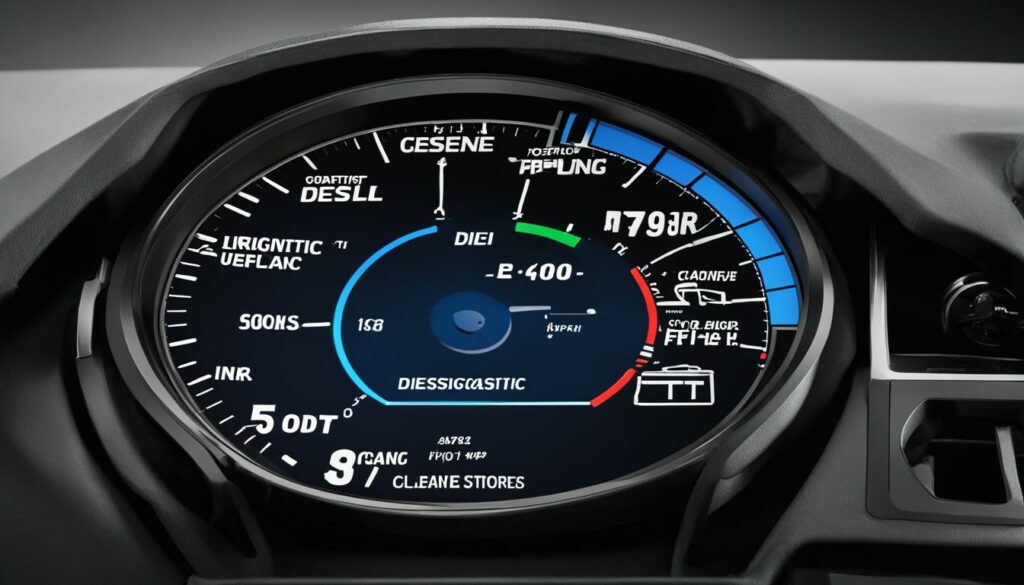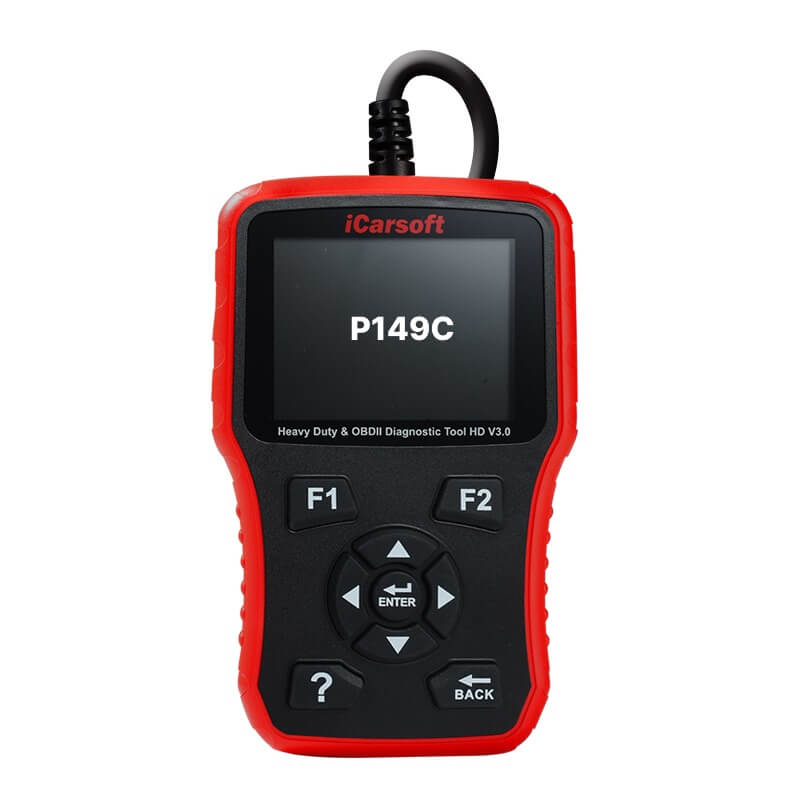P149C – DPF Control Performance
POSTED IN pcodes
The P149C fault code is related to the performance of the Diesel Particulate Filter (DPF) control system. This code indicates an issue with the control of the DPF, which is responsible for filtering soot particles from the exhaust gases of a diesel engine.
A problem with the DPF control system can lead to various symptoms and downgrade operations, affecting the overall performance and efficiency of the engine. It is crucial to troubleshoot and resolve this issue to maintain the proper functioning of the DPF system.
Key Takeaways:
- The P149C fault code relates to the performance of the DPF control system.
- DPF control issues can lead to symptoms such as noise, increased fuel consumption, lack of power, engine hesitations or cut-outs, and smoke from the exhaust.
- Faulty components can cause P149C issues, including the manifold air entry pressure sensor, turbo air cooler by-pass unit, and various other components.
- The severity of the P149C fault code is indicated by downgraded operations and the illumination of the engine warning light.
- Troubleshooting steps involve checking and repairing/replacing faulty components, performing diagnostics, and recalibrating the DPF system.
Symptoms of DPF Performance Issues
When it comes to the performance of your Diesel Particulate Filter (DPF) control system, it is important to be aware of the common symptoms that indicate potential issues. Recognizing these symptoms can help you address problems promptly and ensure optimal engine performance. Here are some key symptoms to watch out for:
Noise
If you notice excessive noise coming from your vehicle’s exhaust system, it could be a sign of DPF performance issues. The DPF is designed to filter out soot particles, but when it malfunctions, it can cause abnormal noises during engine operation.
Increased Diesel Fuel Consumption
Inefficient DPF control can lead to increased diesel fuel consumption. If you find that you are filling up your tank more frequently than usual, it could be a result of a compromised DPF system.
Buy tested tuning file for Adblue / EGR / DPF / Adblue off now!
Lack of Power
A DPF control system that is not functioning properly can lead to a noticeable lack of power in your vehicle. You may experience reduced acceleration or difficulty maintaining speed, indicating an underlying issue that needs to be addressed.
Engine Hesitation or Cutting Out
DPF performance issues can also manifest as engine hesitation or intermittent cutting out. If you feel a loss of power accompanied by jerking or stalling of the engine, it could be a sign of DPF control problems.
Smoke from the Exhaust
Excessive smoke coming from your vehicle’s exhaust is another symptom of DPF performance issues. The DPF is designed to reduce emissions, so if you notice dark or unusual smoke, it indicates a problem with the DPF system.
Addressing these symptoms promptly is crucial to prevent further damage to the DPF system and ensure optimal engine performance. In the next section, we will explore the common causes behind these DPF control performance issues.
Causes of P149C – DPF Control Performance Issues
The efficient functioning of the Diesel Particulate Filter (DPF) control system relies on several crucial components. When these components malfunction, it can result in P149C – DPF Control Performance issues. Here are some common causes:
- Faulty Manifold Air Entry Pressure Sensor
- Turbo Air Cooler By-pass Unit
- Electrovalve of the Turbo Air Cooler By-pass Unit
- Position Indicator of the Turbocharging Air Cooler Bypass Unit
- Turbocharger
- Turbocharger Solenoid Valve
- Position Indicator of the Turbocharger
These components play a critical role in the efficient functioning of the DPF control system. Any malfunction or fault in these components can trigger the P149C fault code and lead to performance issues. It is important to identify and address these causes to ensure optimal diesel particulate filter control.

Diagnostics and Severity of P149C – DPF Control Performance Issues
The technical description of the P149C – DPF Control Performance fault code provides insight into the specific conditions that trigger this issue. It occurs when the engine speed ranges between 2000 to 3000 RPM, while the engine torque remains below 300 Nm. Additionally, the measured turbocharged air pressure should exceed the reference value by 450 mbar for a duration of 6 seconds. These parameters help diagnosticians identify the precise circumstances under which the fault code is triggered.
The severity of the P149C code is indicated by its impact on various engine functions. When this fault occurs, several essential operations are downgraded to prevent further damage. These include the deactivation of fuel injection functions, exhaust heat saver function, EGR function, and kick-down for automatic gearboxes, among others. The engine warning light also illuminates, providing a clear indication to the driver that there is a significant issue affecting the vehicle’s performance and emissions.
To provide a visual representation of the severity levels, here is a table summarizing the downgraded operations enacted when the P149C – DPF Control Performance fault code is detected:
| Downgraded Operations |
|---|
| Deactivation of fuel injection functions |
| Exhaust heat saver function disabled |
| EGR function deactivated |
| Kick-down function for automatic gearboxes disabled |
| Other engine control functions impacted |
Note: The severity of the P149C – DPF Control Performance fault code emphasizes the significant impact it has on the engine’s operations and performance.
Having a clear understanding of the technical description and severity of the P149C – DPF Control Performance fault code is essential for effective diagnostics and resolution. Addressing this issue promptly will help restore the proper functioning of the DPF system, ensuring optimal engine performance and minimizing potential damage.
Solutions for P149C – DPF Control Performance Issues
When troubleshooting P149C – DPF Control Performance issues, it is essential to follow a systematic approach to identify and resolve the underlying problems. This section provides an overview of the recommended troubleshooting steps and solutions to improve DPF control performance.
1. Check and Address Faulty Components
Start by examining the potentially faulty components that could be causing the P149C fault code. These components may include the manifold air entry pressure sensor, turbo air cooler by-pass unit, and other related parts. If any of these are found to be malfunctioning or damaged, they should be repaired or replaced accordingly.
2. Perform Diagnostic Tests and Checks
To further pinpoint the exact issue with the DPF control system, it is advisable to perform diagnostic tests and checks. This may involve using specialized diagnostic equipment to analyze the system’s parameters, sensor readings, and other relevant data. By identifying any underlying issues, you can ensure a more accurate diagnosis and appropriate course of action.
3. Adjustments and Recalibrations
Improving DPF control performance may require making adjustments and recalibrations to the system. This can involve fine-tuning various parameters, such as the DPF regeneration intervals, fuel injection timing, or exhaust gas recirculation settings. Consult the manufacturer’s guidelines or seek professional assistance to ensure proper adjustments are made.
4. Regular Maintenance and Cleaning
Regular maintenance and cleaning of the DPF are crucial for optimal performance. Follow the manufacturer’s recommended maintenance schedule to ensure timely filter replacements and thorough cleanings. Regularly inspect the DPF for any signs of blockage or damage, and clean it using approved cleaning techniques and solutions.
5. Additional Considerations
When working towards improving DPF control performance, it is essential to take into account the overall vehicle condition, fuel quality, and driving habits. Proper maintenance of the entire engine system, including the intake and exhaust systems, can contribute to optimal DPF performance. Additionally, using high-quality fuel and adopting driving practices that minimize excessive idling or short trips can help prevent carbon buildup and reduce the likelihood of DPF-related issues.
By following these troubleshooting steps and implementing the suggested solutions, you can enhance DPF control performance, reduce the occurrence of P149C fault codes, and ensure the proper functioning of the DPF system.

| Potential Solutions | Benefits |
|---|---|
| Repair or replace faulty components | – Restores proper functionality – Addresses specific causes |
| Perform diagnostic tests and checks | – Identifies underlying issues – Improves accuracy of diagnosis |
| Make adjustments and recalibrations | – Optimizes DPF control system – Improves overall performance |
| Regular maintenance and cleaning | – Prevents blockage and damage – Enhances DPF lifespan |
Professional Assistance and Alternative Solutions
If professional assistance is unavailable or if alternative solutions are desired, there are services that offer the option of permanently removing the P149C fault code. This alternative solution involves uploading the Engine Control Unit (ECU) file to a dedicated portal to initiate the removal process.
It is important to note that while this alternative solution can remove the P149C fault code, it may not necessarily address the underlying issue causing the fault code. Therefore, it is crucial to consult with experts or professionals before opting for this solution to ensure a comprehensive diagnosis and proper resolution of the problem.
Additionally, it is important to consider the potential implications of permanently removing the fault code. This solution may have consequences for emissions regulations and vehicle performance, as it alters the original programming of the ECU.
Consulting with professionals can provide valuable insights and guidance in determining the most suitable course of action for addressing the P149C fault code and its associated issues.
Conclusion
Troubleshooting and resolving P149C – DPF Control Performance issues is crucial to ensure the proper functioning of the DPF system and maintain optimal engine performance. By addressing the symptoms, identifying the causes, and implementing suitable solutions, such as repairing or replacing faulty components, adjusting the DPF control system, or seeking professional assistance, it is possible to overcome the issues related to DPF control performance.
Regular maintenance and adherence to recommended maintenance schedules for the DPF system can also help prevent future issues and ensure the longevity of the system. Keeping the DPF system clean and free from excessive soot buildup is essential for its efficient operation. When conducting repairs or inspections, it is important to use genuine parts and follow manufacturer guidelines to ensure the best results.
In cases where professional assistance or alternative solutions are sought, it is advised to consult with experts or professionals who specialize in DPF system troubleshooting and repair. They can provide valuable insights and offer tailored solutions to address specific issues with the DPF control system. It is important to remember that while alternative solutions, such as ECU file upload for permanent fault code removal, may offer temporary relief, they might not address the underlying cause and can have implications for emissions regulations and vehicle performance.
By proactively addressing and resolving P149C – DPF Control Performance issues, vehicle owners can ensure their vehicle’s DPF system operates optimally, resulting in improved engine performance, fuel efficiency, and reduced emissions, all contributing to a healthier environment.
FAQ
What does the P149C fault code indicate?
The P149C fault code relates to the performance of the Diesel Particulate Filter (DPF) control system. It indicates that there is an issue with the control of the DPF, which is responsible for filtering soot particles from the exhaust gases of a diesel engine.
What are the symptoms of P149C – DPF Control Performance issues?
The symptoms may include noise, increased diesel fuel consumption, lack of power, engine hesitating or cutting out, and smoke from the exhaust. These symptoms indicate that there is a problem with the DPF control system, potentially affecting the overall performance and emissions of the vehicle.
What are the common causes of P149C – DPF Control Performance issues?
The common causes can include faulty components such as the manifold air entry pressure sensor, turbo air cooler by-pass unit, electrovalve of the turbo air cooler by-pass unit, position indicator of the turbocharging air cooler bypass unit, turbocharger, turbocharger solenoid valve, and position indicator of the turbocharger.
What is the severity of the P149C fault code?
The severity is indicated by the downgraded operations that are enacted, such as deactivation of certain fuel injection functions, exhaust heat saver function, EGR function, kick-down for automatic gearboxes, and more. The engine warning light will also be illuminated.
How can P149C – DPF Control Performance issues be diagnosed and resolved?
It is recommended to first check and address any faulty components identified as potential causes. This may involve repairing or replacing the manifold air entry pressure sensor, turbo air cooler by-pass unit, or other related components. Additionally, performing diagnostic tests and checks on the DPF control system can help identify any underlying issues. Improving DPF control performance may require adjustments or recalibrations of the system, as well as regular maintenance and cleaning of the DPF itself.
Is professional assistance available for resolving P149C – DPF Control Performance issues?
Yes, professional assistance is available for troubleshooting and resolving these issues. Experts can perform thorough diagnostics and provide expert recommendations for repairs or adjustments to improve DPF control performance.
Are there alternative solutions for P149C – DPF Control Performance issues?
Yes, some services offer the option of permanently removing the P149C fault code. However, it is important to note that this may not address the underlying issue causing the fault code and may have implications for emissions regulations and vehicle performance. Consulting with experts or professionals is recommended before opting for this solution.
What is the importance of resolving P149C – DPF Control Performance issues?
Troubleshooting and resolving these issues is crucial to ensure the proper functioning of the DPF system and maintain optimal engine performance. By addressing the symptoms, identifying the causes, and implementing suitable solutions, it is possible to overcome the issues related to DPF control performance and prevent future damage or inefficiencies.


